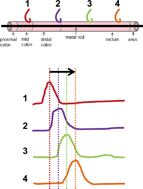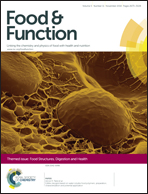An in vitro rat model of colonic motility to determine the effect of β-casomorphin-5 on propagating contractions†
Abstract
Beta-casomorphin-5 (βCM-5) is a milk-derived bioactive peptide that slows gastro-intestinal transit (GIT) in vivo and blocks the peristaltic reflex in the guinea pig colon in vitro. We wanted to establish an in vitro model system in which effects of dairy-derived substances containing opioid peptides on intestinal motility can be assessed and used to predict in vivo outcomes. Because βCM-5 is an opioid agonist that acts on enteric neurons, we used this substance to compare two different isolated colonic tissue preparations to determine which would more closely mimic the in vivo response previously reported in the literature. We compared and characterized the effects of βCM-5 on spontaneous contractions in isolated segments of distal colon (1 cm length) compared with propagating contractions along the isolated intact large intestine (22 cm length). In short segments of distal colon, βCM-5 increased the tension and frequency of spontaneous contractions in a concentration-dependent manner. At 20 μM βCM-5 tension increased by 71 ± 17% and the frequency doubled (n = 9), effects inhibited by naloxone (n = 7) and therefore mediated by opioid receptors. In contrast 20 μM βCM-5 disrupted propagating contractions in the large intestine preparation. At 20 μM βCM-5 reduced the proportion of contractions initiated in the proximal colon reaching the rectum by 83 ± 11% (n = 5) and this effect was also inhibited by naloxone, consistent with altered GIT reported in vivo. Our results demonstrate that the isolated whole large intestine provides an ideal preparation that mimics the reduced propagation of GIT in vivo in response to an opioid agonist, whereas short colon segments did not. The findings of the current study reveal that preserving large segments of intact large intestine, and hence intact enteric neural circuitry provides an ideal in vitro model to investigate the effect of opioid receptor modulators on intestinal transit.

- This article is part of the themed collection: Food Structures, Digestion and Health International Conference

 Please wait while we load your content...
Please wait while we load your content...